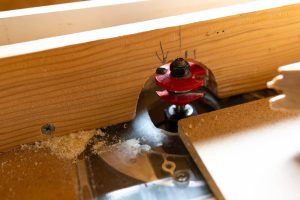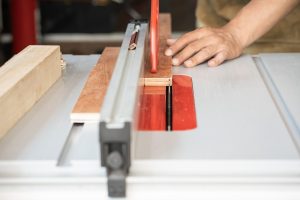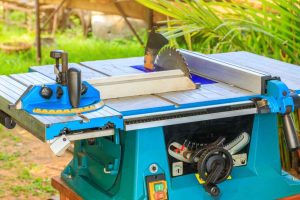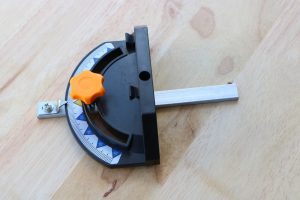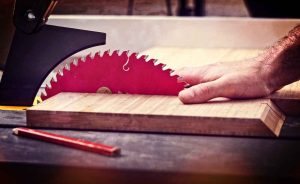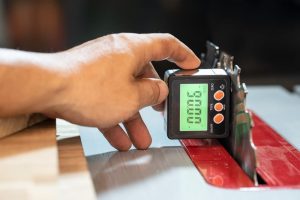Ryobi is a trusted brand in the power tool industry, known for delivering reliable, high-quality tools for both DIY enthusiasts and professionals. When it comes to table saws, Ryobi offers a range of models designed for precision and performance.
However, the right accessories can significantly enhance the functionality, safety, and accuracy of these saws. From improving cut precision to providing added stability and safety features, Ryobi table saw accessories are essential for getting the most out of your equipment.
With the right add-ons, a standard Ryobi table saw transforms into a versatile tool, capable of handling a wider range of woodworking tasks with greater ease and efficiency.
Reasons to Invest in Ryobi Table Saw Accessories
Safety Benefits
Utilizing accessories designed for safety can greatly enhance your woodworking experience. Tools such as push sticks and blade guards are essential in preventing accidents and injuries during operation.
By incorporating these safety features, users can maintain better control over their workpiece, reducing the risk of accidental contact with the blade.
Precision Improvements
Certain accessories are specifically engineered to improve accuracy in cuts. For example, digital measuring devices, miter gauges, and dado blades allow for more precise angles and cleaner edges.
By enhancing your table saw with these tools, you can achieve higher-quality results and more professional-looking projects.
Enhanced Functionality
Add-ons can significantly expand the capabilities of your saw, enabling you to tackle a broader range of tasks. Accessories such as crosscut sleds, router attachments, and extension wings enable you to perform more complex cuts and work with larger materials.
By investing in these enhancements, you can transform your Ryobi table saw into a versatile woodworking machine that meets the diverse demands of various projects.
Unlock Your Ryobi’s Full Potential: A Guide to Essential Table Saw Accessories
So, you’ve got a Ryobi table saw – congratulations! You’ve chosen a fantastic tool that’s the heart of many workshops. While it’s powerful and capable right out of the box, the real magic happens when you start adding the right accessories. These aren’t just fancy add-ons; they are game-changers that boost your precision, expand your capabilities, and, most importantly, keep you safe.
Let’s dive into the must-have accessories that will transform your Ryobi table saw from a good tool into the centerpiece of your woodworking projects.
Miter Gauges: Mastering the Angle
A miter gauge is that T-shaped tool that slides into the grooves (called miter slots) on your saw’s tabletop. Its primary job is to guide your workpiece as you push it past the blade for a crosscut.
- How do they help achieve angled cuts? The head of the miter gauge pivots and locks at specific angles, typically from 0 to 45 degrees in both directions. By setting it to, say, 45 degrees, you can push your wood through to create a perfect miter cut. This is essential for making things like picture frames, boxes, and angled joinery. The stock miter gauge that comes with your Ryobi is a good starting point, but an upgraded one can offer a world of precision.
- Key features of Ryobi-compatible miter gauges: Look for an aftermarket miter gauge that fits a standard 3/4″×3/8″ miter slot, which is common on Ryobi saws. Key features to seek out include:
- Positive Stops: These are preset locking points at common angles like 0∘, 22.5∘, 30∘, and 45∘. They allow you to quickly and accurately set your angle without squinting at the scale.
- Minimal “Slop”: A high-quality gauge will have adjustment screws or nylon fittings to eliminate any wiggle room within the miter slot, ensuring your cuts are perfectly true.
- Extendable Fence: A longer fence provides better support for your workpiece, preventing it from pivoting during the cut and improving accuracy.
Rip Fences and Extensions: The Key to Straight Lines
The rip fence is the long guide that clamps onto your table saw parallel to the blade. Its job is to guide the wood for rip cuts—cuts made along the length of the grain.
- Importance of rip fences for straight cuts: Without a reliable rip fence, making a straight, repeatable cut is nearly impossible. The fence is your reference point. A good one locks down securely and stays perfectly parallel to the blade. This is non-negotiable for ripping boards to a consistent width for projects like cabinet sides, shelves, and tabletops.
- Highlight Ryobi-compatible options and extension kits: Your Ryobi saw comes with a factory rip fence that works well for many tasks. However, its main limitation is the size of the table. When you need to cut large sheets of plywood or MDF, you’ll run out of support. While direct bolt-on fence upgrades are less common for contractor-style saws, the best solution is to build or buy an outfeed table and side extension tables. These tables support the wood as it passes through the blade, allowing you to handle large materials safely and accurately.
Table Saw Stands and Mobility Kits: Work Smarter, Not Harder
A table saw needs a stable and comfortable home. Trying to use it on the floor or a wobbly workbench is both unsafe and will lead to poor results.
- Benefits of using stands for portability and height adjustments:
- Ergonomics: A stand brings the saw up to a proper working height (usually waist-high), saving your back and giving you better control and visibility over the cut.
- Portability: Many Ryobi users have workshops in garages or sheds where space is at a premium. A stand with wheels allows you to easily roll your saw out for use and tuck it away when you’re done.
- Comparison of popular Ryobi-compatible table saw stands: Ryobi makes excellent stands designed specifically for their saws. The two main types are:
- Folding Stands: These are lightweight, simple, and great for quick setup and breakdown. They are perfect if you need to transport your saw to a job site.
- Rolling Stands: These are the most popular choice. They often have large wheels and a clever folding mechanism that allows you to collapse the stand and roll the saw around vertically, much like a hand truck. The Ryobi Universal Rolling Table Saw Stand is a fan favorite and a perfect match.
Dado Throat Plates and Dado Blades: For Professional Joinery
- Explanation of dado cuts and their applications in woodworking: A dado is a square or rectangular channel cut across the grain of a piece of wood. It’s an incredibly strong and clean way to create joints. Think of the slots in a bookcase that hold the shelves—those are dados. They are fundamental to cabinet making and building sturdy furniture. To make these cuts, you need a special blade set.
- Recommended Ryobi dado plates and blade sets: First, check your saw’s manual! Not all table saws are designed to accept a dado stack due to the length of the arbor (the threaded shaft the blade mounts on). If your Ryobi is dado-compatible, you’ll need two things:
- A Stacked Dado Blade Set: This is a set of outer blades and inner “chippers” that you stack together to achieve the desired width of your channel (e.g., 1/4″, 1/2″, 3/4″).
- A Dado Throat Plate: The standard plate that surrounds your blade has a narrow slot. A dado blade is much wider and won’t fit. You need a specific dado throat plate with a wide opening to accommodate the dado stack safely. Ryobi often sells these specifically for their models.
Dust Collection Attachments: A Clean and Healthy Workshop
Table saws produce an enormous amount of sawdust. It gets everywhere, makes cleanup a chore, and more importantly, fine airborne dust is a health hazard.
- Importance of dust collection for cleanliness and safety: A good dust collection system keeps your workspace cleaner, reduces the time you spend sweeping, and protects your lungs from harmful fine particles. It also helps keep your cut line visible and prevents sawdust from building up inside the saw’s motor housing.
- Options for dust ports, vacuum attachments, and Ryobi-specific adapters: Most Ryobi table saws come with a built-in dust port, usually around 2−1/2″ in diameter. The easiest solution is to connect this port directly to a shop vacuum. You may need a universal hose adapter to get a snug fit. For a significant upgrade, consider adding a cyclone dust separator between the saw and the vacuum. This device captures the heavier dust and chips before they reach your vacuum, preventing the filter from clogging and dramatically improving suction efficiency.
Push Blocks and Sticks: Safety First, Always
These are the most important safety accessories you will own. Their one job is to keep your hands and fingers far away from the spinning blade.
- How these accessories promote safe handling: A push stick is used to push narrow pieces of wood through the blade. A push block is even better, as it provides downward pressure on the wood, preventing it from lifting or kicking back, while also pushing it forward. You should never have your hands within several inches of the blade—use a push block or stick instead.
- Overview of Ryobi push blocks/sticks or compatible brands: Your saw likely came with a basic plastic push stick. It’s functional, but you should consider it the absolute minimum. Aftermarket push blocks, like the popular GRR-RIPPER by MicroJig, offer vastly superior control and safety. They grip the wood, hold it tight against the fence, and keep your hands completely out of the danger zone.
Blade Guard Accessories: Your First Line of Defense
The blade guard is the plastic or metal housing that covers the top of the saw blade. It’s often part of an assembly that includes a riving knife (a fin behind the blade that prevents the wood from pinching and causing kickback) and anti-kickback pawls (toothed arms that dig into the wood to stop it from shooting back at you).
- Importance of blade guards in preventing accidents: The blade guard’s purpose is simple: to prevent anything—fingers, loose clothing, scraps of wood—from accidentally contacting the top of the spinning blade. It is your single most effective piece of safety equipment for preventing life-altering injuries.
- Ryobi-specific guard options and universal fits: Always use the blade guard assembly that came with your Ryobi saw. Many woodworkers are tempted to remove it for certain cuts, but it should be reinstalled immediately afterward. If your guard is lost or damaged, you must get a replacement. Contact Ryobi’s parts department or look for parts specific to your saw model number. Never operate the saw without the riving knife in place, at the very least.
By investing in a few of these key accessories, you’ll find your woodworking becomes more precise, more enjoyable, and significantly safer. Happy building!
How to Choose the Right Accessories for Your Needs
Selecting the right accessory isn’t just about grabbing the first one you see. It’s about matching the tool to your projects, your saw, your budget, and your skill level.
Project Type
- Matching accessories to the type of woodworking project. Your project dictates your needs. Think about what you plan to build:
- Fine Furniture & Cabinetry: If you’re building cabinets, bookshelves, or intricate furniture, precision is paramount. Prioritize an upgraded miter gauge for accurate angles and a dado stack with a dado throat plate for strong, clean joinery.
- Large-Scale Projects (Plywood Sheets): Breaking down large sheets of plywood for sheds, workbenches, or shop furniture? Your main focus should be on material support. An outfeed table and side extension tables (whether bought or built) are essential. A high-quality push block is also critical for controlling these large pieces.
- Small Crafts & Boxes: For small projects like jewelry boxes or picture frames, a high-precision miter gauge is your best friend. A thin-kerf blade might also be beneficial to save precious material and get cleaner cuts on delicate wood.
- General DIY & Home Repair: If you’re a weekend warrior fixing things around the house, focus on safety and core functionality. A good set of push blocks, a reliable dust collection setup, and a solid rolling stand will make your work safer and more enjoyable.
Compatibility with Ryobi Models:
- Checking if the accessory fits specific Ryobi table saw models. This is crucial. Always double-check compatibility before you buy.
- Check Your Manual: Your saw’s manual is your best friend. It will list key specifications like the miter slot dimensions (most Ryobi saws use a standard 3/4″×3/8″ slot), the blade arbor size, and whether it supports a dado stack.
- For Universal Accessories (Miter Gauges, Push Blocks): As long as the miter gauge bar matches your slot size, it will fit. Push blocks are universal.
- For Model-Specific Accessories (Throat Plates, Blade Guards): These items are NOT one-size-fits-all. You must buy the specific part designed for your exact Ryobi saw model number. Check the product listing or the manufacturer’s website for compatibility information.
Budget Considerations:
- Tips on balancing cost with quality and necessity. You don’t have to buy everything at once. Prioritize your purchases based on impact and safety.
- Safety First (Non-Negotiable): Your first dollars should go towards high-quality push blocks and a functional dust collection system. Never compromise on safety.
- Precision Next: An upgraded miter gauge will provide the biggest improvement in cut quality and accuracy for the money.
- Convenience and Capability Last: Accessories like dado stacks and mobility stands can be added later as your projects and needs evolve. Remember the old saying: “Buy nice or buy twice.” A cheap, flimsy accessory can be frustrating and even dangerous. It’s often better to save up for a quality tool that will last.
User Skill Level:
- Selecting accessories based on experience.
- Beginner: Focus on the fundamentals of safety and accuracy. Master your saw with a good stand, excellent push blocks, and a reliable dust collection hookup. The factory fence and blade are sufficient while you’re learning.
- Intermediate: You’re comfortable with the basics and are ready for more complex projects. This is the time to invest in a precision miter gauge, a dado stack, and perhaps build an outfeed table to handle larger projects.
- Advanced: You’re tackling fine furniture and complex joinery. You might look into specialized jigs, high-end crosscut sleds (which you can build yourself!), and premium blades designed for specific tasks like ripping or crosscutting.
Best Places to Buy Ryobi Table Saw Accessories
Recommended stores (Home Depot, Lowe’s, etc.) and online marketplaces.
- The Home Depot: As the primary retail partner for Ryobi, this is your number one spot for Ryobi-branded accessories like stands, throat plates, and replacement parts.
- Amazon: Offers a massive selection of both Ryobi products and third-party compatible accessories like miter gauges, blades, and push blocks from a wide range of brands. User reviews can be very helpful here.
- Specialty Woodworking Stores (e.g., Rockler, Woodcraft): These are the best places to find high-end, third-party accessories. If you’re looking for a premium miter gauge, dado stack, or advanced safety equipment, these retailers are a goldmine of quality options and expert advice.
- Lowe’s & other Hardware Stores: While they may not carry as much Ryobi-specific gear, they often have a good selection of universal accessories like saw blades, push sticks, and shop vacuum adapters.
Pros and cons of buying from big-box stores versus specialty tool retailers.
Big-Box Stores (The Home Depot)
- Pros: Convenient, can see the product in person, easy returns, often the only source for brand-specific replacement parts.
- Cons: Limited selection of high-end third-party brands, staff may have general rather than specialized knowledge.
Specialty Tool Retailers (Rockler, Woodcraft)
- Pros: Huge selection of premium and innovative accessories, highly knowledgeable staff who are often woodworkers themselves, great place to discover new tools.
- Cons: Can be more expensive, may not have a physical location near you (though their online stores are excellent).
Maintenance Tips for Ryobi Table Saw Accessories
Proper care ensures your accessories perform well for years.
Cleaning and care recommendations for each accessory type
- Miter Gauges & Fences: Wipe them down regularly to remove sawdust. Apply a light coat of paste wax to the metal bars and fence faces. This prevents rust and allows them to glide smoothly.
- Blades & Dado Stacks: Wood resin (pitch) builds up on blade teeth, causing friction and burning. Clean them regularly with a specialized blade and bit cleaning solution and a brass brush.
- Throat Plates: Keep the plate and the recess it sits in clean of sawdust buildup to ensure it sits perfectly flush with the tabletop.
- Push Blocks/Sticks: Wipe them clean. Check the rubber pads on push blocks to ensure they aren’t worn out, as their grip is essential for safety.
Storage tips to prolong accessory life
- Blades: Never store blades loose in a drawer where the carbide teeth can chip. Use the plastic cases they came in or store them on a dedicated blade rack.
- Miter Gauge: Hang it on a wall or store it in a dedicated drawer. Avoid leaving it on the floor where it could be stepped on or knocked out of alignment.
- General Rule: Keep all metal accessories in a dry environment to prevent rust. A dry shop is a happy shop.
Frequently Asked Questions (FAQs)
Are Ryobi table saw accessories compatible with other brands?
It depends. Universal accessories like miter gauges (that fit the 3/4″×3/8″ slot), blades (that match the arbor size), and push blocks are often cross-compatible. However, model-specific parts like throat plates, riving knives, and blade guards are seldom interchangeable between brands.
Can I use a Ryobi table saw without any accessories?
Technically, the saw functions out of the box with its included blade, fence, miter gauge, and safety guards. However, using it without a push stick or push block for certain cuts is extremely dangerous. The included accessories are the bare minimum for operation; upgrading them enhances safety and precision.
What are the best accessories for beginners?
The top three for any beginner are: 1) A high-quality push block for safety. 2) A reliable dust collection system (even just a shop vac) for health and cleanliness. 3) An upgraded miter gauge for a dramatic and immediate improvement in cut accuracy.
How do I know if an accessory fits my Ryobi table saw?
Check three things: 1) Your saw’s manual for specifications. 2) The accessory’s product description for its dimensions and compatibility list. 3) For model-specific parts, match the accessory to your saw’s exact model number.
Are aftermarket accessories safe for use with Ryobi table saws?
Yes, provided you buy from reputable, well-known brands (e.g., Forrest, Freud, Incra, MicroJig). These companies engineer their products to high standards. Be wary of unbranded, cheap knock-offs from online marketplaces, as their quality and safety cannot be guaranteed.
Conclusion
Your Ryobi table saw is a powerful and versatile tool, but it’s the accessories that truly define its limits. Choosing the right accessories is an investment in your craft.
They are the bridge between a rough cut and a fine finish, between a difficult task and an efficient one, and most critically, between a potential hazard and a safe workshop.
By carefully selecting high-quality accessories that match your projects and your saw, you enhance your precision, boost your efficiency, and reinforce a culture of safety. Don’t hesitate to invest in these critical tools—they will pay you back with every clean, accurate, and safe cut you make.
